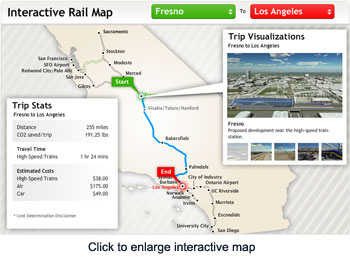We’ve seen some high profile examples in recent years of how hard it is to forecast patronage on new transport infrastructure.
The Cross City tunnel in Sydney and the Clem 7 in Brisbane, for example, have both performed well below forecasts. Even when it was free, the Cross City tunnel did not approach the forecast volumes (PDF 214KB) of 90,000 vehicles per day. Traffic volumes on the cross-river tunnel in Brisbane fell from almost 60,000 during the free period to around 20,000 in the first week of tolling.

Advertisement
California’s planned $42 billion High Speed Rail (HSR) project provides another example of the difficulties of forecasting demand. Although there are important differences between the design of the California HSR system and proposals for a Very Fast Train (VFT) between Sydney-Canberra-Melbourne, the former nevertheless has important lessons for us. I have previously discussed the VFT here, here, here and here.
A new analysis (PDF 2.15MB) by the Institute of Transportation Studies, University of California Berkeley, found significant problems with the demand modelling and analysis undertaken for the California project by Cambridge Systematics (CS) “that render the key demand forecasting models unreliable for policy analysis”.
The lead paragraph of a story on the issue in the Los Angeles Times says “Ridership forecasts for the California high-speed rail project are so unreliable that it is difficult to predict whether the proposed bullet train would be profitable or suffer severe revenue shortfalls, according to a report released Thursday by transportation experts at UC Berkeley”.
The study was requested by the Chair of the state Senate Transportation and Housing Committee overseeing the project and was funded by the HSR Rail Authority itself.
The LA Times says the UC Berkeley researchers concluded that there are problems in the statistical model used for the forecasts, including methods that exaggerated the importance of frequent train service; faulty assumptions about which stations travellers would use; and inadequate sampling of long-distance travellers that was compensated for by using a technique that has been deemed obsolete.
The researchers summarise one of the key shortcomings as follows:
Advertisement
In broad terms, the approach taken by CS includes a model development phase and a model validation phase. In the model development phase, both historical data and survey data were employed to develop a mathematical model of interregional travel. The individuals surveyed were interregional trip makers. However, the mode choices of the individuals surveyed were not representative of California interregional travellers. For example, nearly 90% of long distance (over 100-mile) business passenger trips are made by car, while 78% of the long distance business travellers sampled for the study were travelling by air.
They conclude that “the true confidence bands around the estimates from these models must be very wide. They are probably wide enough to include demand scenarios where HSR will lose substantial amounts of money as well as those where it will make a healthy profit”.
The take-home message is that not all infrastructure projects are guaranteed to deliver a motza, at least not any more. Maybe the Premier of Victoria has a point when he emphasises that one of the benefits of PPPs for taxpayers is that providers carry the risks (or at least are supposed to).
Discuss in our Forums
See what other readers are saying about this article!
Click here to read & post comments.
1 post so far.